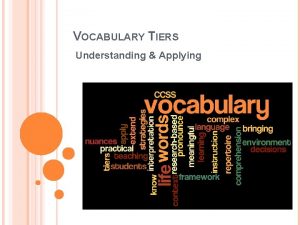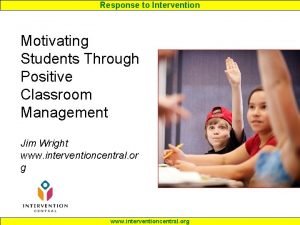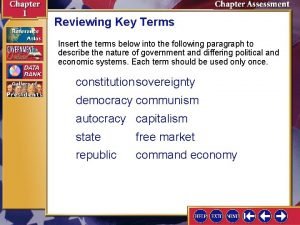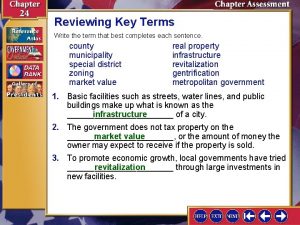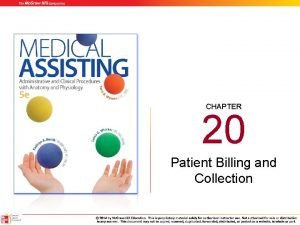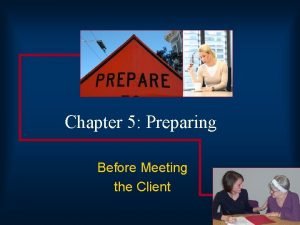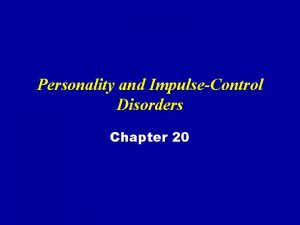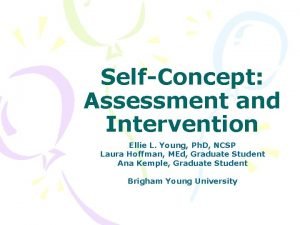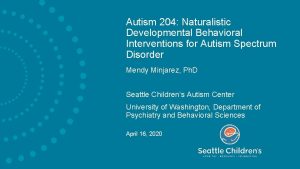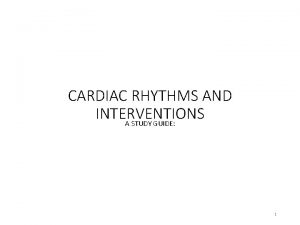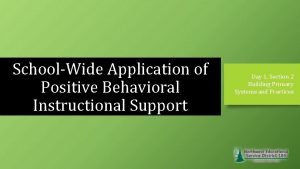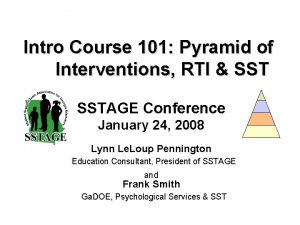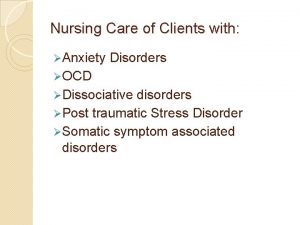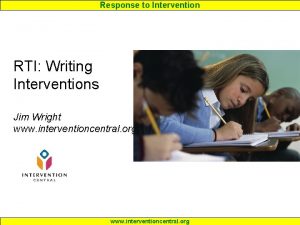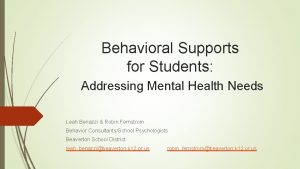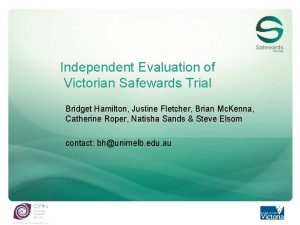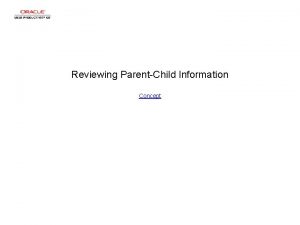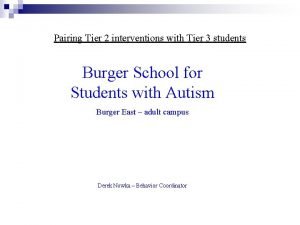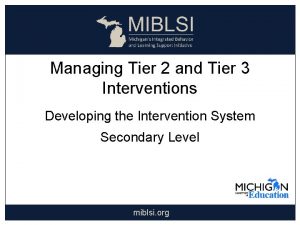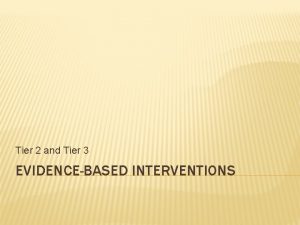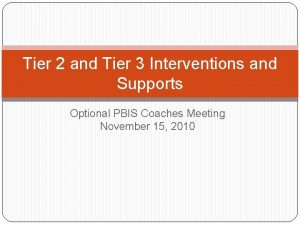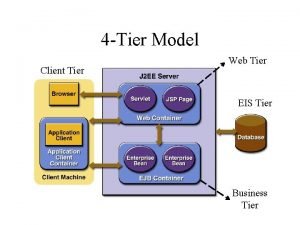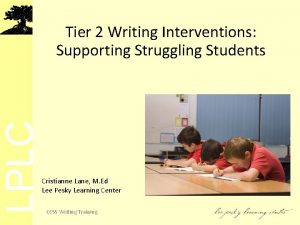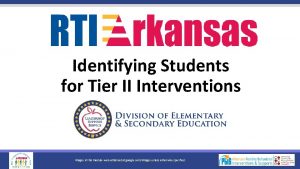Reviewing Tier II Interventions Matching Students to Tier


























































- Slides: 58

Reviewing Tier II Interventions Matching Students to Tier II Interventions and Ensuring Active Ingredients are Implemented

Review of Active Ingredients Intervention Active Ingredients Behavior contract Check in/Check out Self-monitoring protocol School-home note system Class pass intervention Positive peer reporting 2 Diana Browning Wright, M. S. , L. E. P. & Clayton R. Cook, Ph. D.

Myths About Interventions The Silver Bullet One Size Fits All Interventions are found equally liked by all staff Too little time and not enough staff 3 Diana Browning Wright, M. S. , L. E. P. & Clayton R. Cook, Ph. D.

Matching Students to Tier II Interventions Tier II intervention are less effective when educators haphazardly assign them to students Rather, educators must ask: what Tier II intervention is likely to be most effective for particular students? Matching characteristics of the student to characteristics of the intervention Student Intervention Matching Form (SIM-Form) 4 Diana Browning Wright, M. S. , L. E. P. & Clayton R. Cook, Ph. D.

Purpose of Tier II Interventions ~10 -20% of students who continue to experience emotional and behavioral problems despite the implementation of Tier I supports Detected as at-risk by universal screening Aim is secondary prevention, which is to reverse or reduce emotional and behavioral problems Prevent harm or disrupt trajectory towards negative outcomes Helps create more orderly and safe learning environments Diana Browning Wright, M. S. , L. E. P. & Clayton R. Cook, Ph. D. 5

Adapted from: Sprague & Walker, 2004 Selected (At-risk Students) Classroom & Small Group Strategies (10 -20% of students) 6 Diana Browning Wright, M. S. , L. E. P. & Clayton R. Cook, Ph. D.

Menu of Evidence-based Tier II Interventions Mentor-based support* e. g. , Check in/Check out Behavior contracting* Self-monitoring* School-home note system* Dependent group contingency (one student earns for all) First Step to Success Choice-making TIER II Interventions Diana Browning Wright, M. S. , L. E. P. & Clayton R. Cook, Ph. D. Progress monitoring combined with rewarding goal attainment* Class Pass Intervention* Positive Peer Reporting Academic intervention to address skill deficit Noncontingent Reinforcement Small group social skills or social-emotional learning* TIER II Interventions 7

Active Ingredients Just like a good cooking recipe, Tier II interventions involve certain ingredients that must be present in order to achieve successful behavior change Educators, therefore, must be aware of the active ingredients that must be in place to make a particular Tier II intervention effective 8 Diana Browning Wright, M. S. , L. E. P. & Clayton R. Cook, Ph. D.

Behavioral Contract Process of negotiating an agreement between staff and a student so each party receives some benefit or payoff Teacher benefits by improved student behavior Student benefits by earning something based on good behavior Components of behavioral contract: Description of the desired, expected behaviors to be performed Goal statement specifying by when, what behavior, and under what conditions reward will be earned Identification of the reward(s) to be earned (i. e. , The Pay-Off) Signatures from all parties involved Diana Browning Wright, M. S. , L. E. P. precorrects & Clayton R. Cook, Ph. D. and prompts student on daily Teacher 9

Behavior Contract: Student Characteristics Designed for students who respond well to school-based incentives Eager to earn rewards, special privileges, and/or recognition from others Students who dislike particular academic subjects and could benefit from receiving extrinsic reinforcement (i. e. , pay-off) Students who could benefit from receiving precorrection and prompting 10 Diana Browning Wright, M. S. , L. E. P. & Clayton R. Cook, Ph. D.

Behavior Contract: Active Ingredients 1. Negotiated agreement or brokered deal to increase student buy-in 2. Focus on positive behaviors teachers want to see in the classroom (i. e. , those behaviors that are incompatible with problem behavior) 3. Positive reinforcement for meeting goal 4. Teacher follows up with daily pre-correction and prompting Pulling out the contract and reminding the student of the behavior and reward to be earned At the first warning signs of problem behavior, prompting the student Diana Browning Wright, M. S. , L. E. P. & Clayton R. Cook, Ph. D. 11

Difference Between Effective and Ineffective Behavior Contracts Negotiated agreement Non-negotiated Describes what the Provides a goal Provides no goal Outlines what the Outlines how the student should do statement student will earn as a reward for meeting goal Teacher uses contract to precorrect and prompt behavior Effective Behavior Contract Diana Browning Wright, M. S. , L. E. P. & Clayton R. Cook, Ph. D. student is doing wrong statement student will be punished if problem behavior continues No other adult follow through with the Ineffective contract Behavior Contract 12

5 Steps to Implementing Behavioral Contract 1. Arrange a meeting between the student and adults Who should attend the meeting: Parent(s), teacher, behavioral specialist, counselor, administrator Purpose of the meeting: Not to condemn, reprimand, or remind the student of the wrongs in his way of behaving “We are here because things aren’t working for you or us, so we want to make a deal with you. You have something we want and we have stuff that you want. ” 13 Diana Browning Wright, M. S. , L. E. P. & Clayton R. Cook, Ph. D.

5 Steps to Implementing Behavioral Contract 2. Holding the meeting to negotiate and develop the behavior contract Introductions and description of the meaning and purpose of a contract so the student has concept and understanding of what a contract entails. The introductions should not involve emphasizing what the student has done wrong, but rather that the current situation is not working for anyone and there is a need to work out a deal. The adults are willing to have the student have some say in what does on instead of telling the student what to do. It is important to make it a big deal. Describe how a contract is essentially a legally binding deal Make sure to describe the contract in kid-friendly language so they are able to comprehend. 14 Diana Browning Wright, M. S. , L. E. P. & Clayton R. Cook, Ph. D.

5 Steps to Implementing Behavioral Contract Describe the alternative appropriate behaviors or social skills you would like to see and gather the student’s input to get him to commit to engage in those behaviors. Make sure the student is actually capable of exhibiting the appropriate behaviors; therefore, the positive behavior or social skill is within the student’s repertoire and all that is needed is a motivational component that encourages the student to display the behaviors he already knows how to exhibit. If the student can’t exhibit the appropriate behaviors or social skills because he has not learned them, then time will need to be devoted to teaching the student how to exhibit them using a tell-show-do instructional approach. 15 Diana Browning Wright, M. S. , L. E. P. & Clayton R. Cook, Ph. D.

5 Steps to Implementing Behavioral Contract Help the student identify rewards, activities, or privileges to be earned if he is able to hold up his end of the bargain by meeting the goal This should be student-driven in that the student selects preferred items, activities or rewards that he will earn based on good behavior. An important consideration is how frequently should the reinforcer or reward be earned? A good rule of thumb is to gauge how the long the student can actually delay gratification. This entails considering how the far the student can look into the future and wait. If the student can only think a day at a time, then he should be able to earn the reinforcer or reward on a daily basis. Generally, the younger the student, the more frequent they will need to be able to earn the reinforcer or reward. 16 Diana Browning Wright, M. S. , L. E. P. & Clayton R. Cook, Ph. D.

5 Steps to Implementing Behavioral Contract 3. Making copies of the behavior contract for all parties involved Everyone including the student should have a copy of the behavior contract. Make extra copies of the behavior contract just in case the student loses his copy. If the student loses the behavior contract, there is no need to lecture the student and/or discipline him. Instead, simply provide him with another one and continue implementing the steps. 17 Diana Browning Wright, M. S. , L. E. P. & Clayton R. Cook, Ph. D.

5 Steps to Implementing Behavioral Contract 4. Teacher implementation of precorrection and prompting Precorrection involves the teacher reminding the student of the expectations outlined in the behavior contract prior to class beginning or transitioning to other activities under which the student has a history of exhibiting emotional and/or behavior problems. These precorrection gestures or statements are best delivered immediately preceding the context in which the behavior is expected and provide students with a reminder to increase the probability of success. The prompting tactic consists of responding to incidents of the student’s problem behavior by cueing them to engage in the appropriate behavior or social skill outlined on the contract and reminding them of the reward to be earned. If the behavior problem continues despite providing a few prompts, then the teacher should carry out the typical Diana Browning Wright, M. S. , L. E. P. & Clayton R. Cook, Ph. D. 18

5 Steps to Implementing Behavioral Contract 5. Follow-up to ensure fidelity of implementation and troubleshoot any problems Problems to troubleshoot: Student isn’t interested in the reward Experiment with other reinforcers, ask the student to identify reinforcer, or have the student sample the reinforcer Student has to wait too long to get access to reinforcer (pay off) Allow the student to access reinforcers in shorter periods of time or deliver tokens that can be periodically given and exhcanged for desired items/privileges Teacher does not implement precorrection and prompting Performance-based feedback 19 Diana Browning Wright, M. S. , L. E. P. & Clayton R. Cook, Ph. D.

Empirical Support for Behavioral Contracting Miller, D. L. , & Kelley, M. L. (1994). The use of goal setting and contingency contracting for improving children’s homework performance. Journal of Applied Behavior Analysis, 27, 73 -84. Allen, L. J. , Howard, V. F. , Sweeney, W. J. , & Mc. Laughlin, T. F. (1993). Use of contingency contracting to increase on-task behavior with primary students. Psychological Reports, 72, 905 -906. Mruzek, D. W. , Cohen, C. , & Smith, T. (2007) Contingency contracting with students with autism spectrum disorders in a public school setting. Journal of Developmental and Physical Disabilities, 19, 103 -114. De Martini-Scullly, D. , Bray, M. A. , & Kehle, T. J. (2000). A packaged intervention to reduce disruptive behavior in general education students. Psychology in the Schools, 37, 149 -156. Beidel, D. C. , Turner, S. M. , Taylor-Ferreira, J. C. (1999). Teaching study skills and test-taking strategies to elementary school students: The Testbusters program. Behavior Modification, 23, 630 -646. Diana Browning Wright, M. S. , L. E. P. & Clayton R. Cook, Ph. D. 20

Mentor-Based Support: Check-in/Check-out Assignment of a mentor who provides unconditional positive regard and feedback on a daily basis Implementation of multiple components: Behavioral momentum (i. e. , getting the day off to a good start) Precorrection (i. e. , cutting problems off before they start) Performance feedback (i. e. , letting the student know how s/he is doing) Positive reinforcement (i. e. , recognizing and rewarding the student) Diana Browning Wright, M. S. , L. E. P. & Clayton R. Cook, Ph. D. 21

Simple vs. Structured Mentoring Mentor meets with the child once or twice a week Mentor is there to be a positive role modeldoesn’t provide precorrection Can handle significantly more students Simple Mentoring Mentor meets with the child on a daily basis Mentor precorrects problem behavior Daily ratings of behavior performance Limitations with regard to the number of students a school can handle Structured Mentoring 22 Diana Browning Wright, M. S. , L. E. P. & Clayton R. Cook, Ph. D.

Mentor-Based Support Basic Sequence of Structured Mentoring • Deliver consequences at home based on behavior at school • Provide encouragement for a better day tomorrow Parent Check In upon arrival home Morning check in with mentor • Positive greeting • Deliver praise/reward • Provide nonjudgmental feedback End of day check out with mentor Diana Browning Wright, M. S. , L. E. P. & Clayton R. Cook, Ph. D. • • Positive greeting Check for school readiness Cutoff problems before Reminder of expected behaviors • Talk about reward to be earned • Give student monitoring chart Teacher evaluation and ongoing feedback • Teacher monitoring • Prompts to engage in expected behavior • Reminder of reward to be 23 earned

Mentor-Based Support: Student Characteristics Students who respond well to adult attention Students who could benefit from having a positive adult role model outside of the home Students who could benefit from receiving daily encouragement and feedback to improve behavior and school performance Students who have been involved with negative interactions with teachers and administrators (punitive discipline) 24 Diana Browning Wright, M. S. , L. E. P. & Clayton R. Cook, Ph. D.

Mentor-Based Support: Active Ingredients 1. Assignment of an adult mentor who the student likes or doesn‘t mind meeting with 2. Unconditional positive regard (mentor does not get involved with discipline) 3. Daily contact with the student in the morning and afternoon Encouragement, precorrecting problems, feedback 4. Progress monitoring form to serve as a basis for performance-based feedback 5. Positive reinforcement for improved behavior Praise, public recognition, access to desired privileges/rewards Diana Browning Wright, M. S. , L. E. P. & Clayton R. Cook, Ph. D. 25

26 Diana Browning Wright, M. S. , L. E. P. & Clayton R. Cook, Ph. D.

Daily Behavior Report Card 2 = excellent (no problems) 1 = good (1 one or two prompts, but desired behavior occurred) 0 = unacceptable (three or more prompts, with no compliance) 27 Diana Browning Wright, M. S. , L. E. P. & Clayton R. Cook, Ph. D.

Empirical Support for Mentor-based Support Todd, A. W. , Campbell, A. L. , Meyer, G. G. , & Horner, R. H. (2008). The effects of a targeted intervention to reduce problem behaviors: Elementary school implementation of Check in-Check out. Journal of Positive Behavior Interventions, 10, 46 -55. Hawken, L. S. , Mac. Leod, K. S. , & Rawlings, L. (2007). Effects of the Behavior Education Program on office discipline referrals of elementary school students. Journal of Positive Behavior Interventions, 9, 94 -101. Filter, K. J. , Mc. Kenna, M. K. , Benedict, E. A. , Horner, R. H. , Todd, A. W. , & Watson, J. (2007). Check in/Check out: A post-hoc evaluation of an efficient, secondary-level targeted intervention for reducing problem behaviors in schools. Education & Treatment of Children, 30, 69 -84. Lehr, C. A. , Sinclair, M. F. , & Christenson, S. L. (2004). Addressing student engagement and truancy prevention during the elementary school years: A replication study of the Check & Connect Model. Journal of Education for Students Placed at Risk, 9, 279 -301. 28 Diana Browning Wright, M. S. , L. E. P. & Clayton R. Cook, Ph. D.

Self-Monitoring Intervention designed to increase self- management by prompting the student to selfreflect on performance and self-record behavior on a chart Two main components: Self-reflection (reflection of behavior over a certain amount of time) Self-recording (marking down on the chart whether behavior met or did not meet expectations) Teacher performs periodic honesty checks 29 Diana Browning Wright, M. S. , L. E. P. & Clayton R. Cook, Ph. D.

Self-Monitoring: Student Characteristics Students who lack self-regulation or management Students who engage in relatively frequent rates of problem behavior Students who could benefit from reminders or prompts to stay on task and engage in desired, expected behaviors 30 Diana Browning Wright, M. S. , L. E. P. & Clayton R. Cook, Ph. D.

Self-Monitoring: Active Ingredients 1. Identification of behaviors to self-reflect upon and selfrecord on a chart 2. Development of a self-monitoring chart that the students uses to record his/her behavior 3. Device or natural break that prompts the student to selfreflect and self-record behavior 4. Train the student (tell-show-do) 5. Positive reinforcement component attached to selfmonitoring chart (increases the value or meaning of selfreflection and recording) 6. Teacher conducts periodic honesty check 31 Diana Browning Wright, M. S. , L. E. P. & Clayton R. Cook, Ph. D.

How To Do a Self-Monitoring Intervention…. Step 1: 1 Identify what the student should be doing instead of the problem behaviors Can be more than one thing: e. g. , Sitting in seat, keeping desk clean, respectful to others, following directions, participating in class, interacting with others etc. Make sure that student understands and knows how to perform the behaviors that are expected of him/her Link the behaviors to the specific performance goals 32 Diana Browning Wright, M. S. , L. E. P. & Clayton R. Cook, Ph. D.

How To Do a Self-Monitoring Intervention…. Step 2: Determine how frequently the student will selfmonitor and record his/her behaviors Rule of thumb is the more times the problem behavior occurs, the more frequently students need to selfmonitor Can have student self-monitor once every five minutes, at every natural break during the day, or twice daily (e. g. , once before lunch and once at the end of the day) 33 Diana Browning Wright, M. S. , L. E. P. & Clayton R. Cook, Ph. D.

How To Do a Self-Monitoring Intervention…. Step 3: Develop self-monitoring chart and decide how student will be prompted to self-monitor Have natural breaks in the class (e. g. , recess, lunch, transition to library) prompt student to self-monitor Use of vibrating watches or clocks to trigger student to self-monitor Computer software Step 4: Develop a goal with the student and identify the reinforcers the student will earn if the goal is met This will make the chart take on value and become a currency that can be exchanged for desirable goods Diana Browning Wright, M. S. , L. E. P. & Clayton R. Cook, Ph. D. 34

How To Do a Self-Monitoring Intervention…. Step 5: Start the self-monitoring intervention Student will likely need reminders to self-monitor at the beginning Teacher conducts periodic honesty checks of the student’s recording Put a slash (/) through the circle if you agree with the student and an X if you disagree 35 Diana Browning Wright, M. S. , L. E. P. & Clayton R. Cook, Ph. D.

How To Do a Self-Monitoring Intervention…. 36 Step 6: Collect the self-monitoring charts Determine whether the student is complying with the intervention and meeting preset goals Provide feedback to the student based on performance 36 Diana Browning Wright, M. S. , L. E. P. & Clayton R. Cook, Ph. D.

How To Do a Self-Monitoring Intervention…. 37 Step 7: Data-based decision Leave the intervention in place Student is responding, but not enough Change the intervention Intervention is not working Stop the intervention (back to Tier I) Student responded adequately to the intervention 37 Diana Browning Wright, M. S. , L. E. P. & Clayton R. Cook, Ph. D.

Self-Monitoring Technology 38 Diana Browning Wright, M. S. , L. E. P. & Clayton R. Cook, Ph. D.

39 Diana Browning Wright, M. S. , L. E. P. & Clayton R. Cook, Ph. D.

40 Diana Browning Wright, M. S. , L. E. P. & Clayton R. Cook, Ph. D.

41 Diana Browning Wright, M. S. , L. E. P. & Clayton R. Cook, Ph. D.

Empirical Support for Self-Monitoring Interventions Rock, M. L. , & Thead, B. K. (2007). The effects of fading a strategic self- monitoring intervention on students’ academic engagement, accuracy, and productivity. Journal of Behavioral Education, 16, 389 -412. Gureasko-Moore, S. , Du. Paul, G. J. , & White, G. P. (2007). Self- management of classroom preparedness and homework: effects on school functioning of adolescents with Attention Deficit Hyperactivity Disorder. School Psychology Review, 36, 647 -664. Petscher, E. S. , & Bailey, J. S. (2006). Effects of training, prompting, and self-monitoring on staff in a classroom for students with disabilities. Journal of Applied Behavior Analysis, 39, 215 -226. Peterson, L. D. , Young, K. R. , Salzberg, C. L. , West, R. P. , & Hill, M. (2006). Using self-management procedures to improve classroom social skills in multiple general education settings. Education & Treatment of Children, 29, 1 -21. Crawley, S. H. , Lynch, P. , & Vannest, K. (2006). The use of self- monitoring to reduce off-task behavior and cross-correlation examination Diana Browning Wright, M. S. , L. E. P. & Clayton R. Cook, Ph. D. as an antecedent to off-task behavior. Child of weekends and absences 42

School-Home Note System Intervention designed to improve the communication and consistency of practices between school and home environments Involves training parents to deliver consequences at home based on their child’s behavior at school Parent can share information with school about outside stressors that may be impacting student behavior at school 43 Diana Browning Wright, M. S. , L. E. P. & Clayton R. Cook, Ph. D.

School-Home Note Decision Tree BEHAVIORAL GOAL MET YES - GOAL MET NO - GOAL UNMET PARENT RESPONSE CELEBRATE YOUR CHILD’S SUCCESS ENCOURAGE YOUR CHILD TO HAVE A BETTER DAY TOMORROW (discipline) 44 Diana Browning Wright, M. S. , L. E. P. & Clayton R. Cook, Ph. D.

Consequences Delivered by Parents Celebrating the child’s success (aim is to create positive contrast by making the child’s life more exciting, pleasurable, and/or fun) Access to privileges Computer time, video games, talking on the phone, staying up later, hanging out with friends, TV time Reward with item or activity Buy-out of chore, money, invite friend over, play outside, after dinner dessert, playing with toys, etc. Praise and positive recognition 45 Diana Browning Wright, M. S. , L. E. P. & Clayton R. Cook, Ph. D.

Consequences Delivered by Parents Encouraging a better day tomorrow (aim is to create negative contrast by making the child’s life boring, unpleasant, or introducing nothing) Loss of privileges Removal of TV time, computer, video games, playing outside, talking on the phone, or anything else that is considered to be fun Task-based grounding Have the child perform chores that are outside of typical responsibilities Grounded until the chore or chores are completed 46 Diana Browning Wright, M. S. , L. E. P. & Clayton R. Cook, Ph. D.

47 Diana Browning Wright, M. S. , L. E. P. & Clayton R. Cook, Ph. D.

School-Home Note: Student Characteristics Students whose parents are open and willing to join forces with the school to improve the student’s performance in school Students who are unaffected by typical school- based disciplinary consequences Students whose parents could benefit from learning skills Students who could benefit from consistency across school and home environments 48 Diana Browning Wright, M. S. , L. E. P. & Clayton R. Cook, Ph. D.

School-Home Note: Active Ingredients 1. Development of a school-home note that captures student behavior and communicates with parents Student behavior section, teacher communication section, parent response to note section, parent communication section, & signatures 2. Brief parent training that consists of teaching parents how to translate the information on the school-home note into effective parenting strategies Goal met = celebrating success Goal unmet = encouraging a better day tomorrow 3. Ensuring that parents are receiving the note & Diana Browning Wright, M. S. , L. E. P. & Clayton R. Cook, Ph. D. 49

Empirical Support for School-Home Note System Kelley, M. L. (1990). School-home notes: Promoting children’s classroom succes. New York, NY: Gilford Press. Mc. Cain, A. P. & Kelley, M. L. (1993). Managing the classroom behavior of an ADHD preschooler: The efficacy of a school-home note intervention. Child & Family Behavior Therapy, 15, 33 -44. Mc. Cain, A. P. , & Kelley, M. L. (1994). Improving classroom performance in underachieving preadolescents: The additive effects of response cost to a school-home note system. Child & Family Behavior Therapy, 16, 2741. Ascher, C. (1988). Improving the school-home connection for poor and minority urban students. The Urban Review, 20, 109 -123. 50 Diana Browning Wright, M. S. , L. E. P. & Clayton R. Cook, Ph. D.

Class Pass Intervention designed for students who exhibit disruptive classroom behavior that interferes with their and other students’ ability to learn Students are given class passes and taught how to appropriately request a break by issuing a class pass Students can choose to hold on to the class passes in order to exchange them for an item, activity, or special privilege It works because students: Can exercise choice by requesting a break with class pass Tolerance for academic work is increased Diana Browning Wright, M. S. , L. E. P. & Clayton R. Cook, Ph. D. Are able to earn access to desired reward/activity based on 51

Class Pass Intervention: Student Characteristics Students who engage in classroom behavior problems only Students whose academic skills are low and are likely to engage in escape-motivated disruptive classroom behaviors Students who have a low tolerance for engaging in academic work Students who appear to become frustrated when working on academic tasks 52 Diana Browning Wright, M. S. , L. E. P. & Clayton R. Cook, Ph. D.

Class Pass Intervention: Active Ingredients 1. Develop the actual class passes to be used 2. Determine the number of class passes and length of time the student can break for 3. Identify the location for the break (desk, in the classroom, outside of the classroom) 4. Identify the items, privileges, or activities that can be earned and the number of class passes needed for each one 53 Diana Browning Wright, M. S. , L. E. P. & Clayton R. Cook, Ph. D.

Example of a Class Pass FRONT BACK Guidelines for Class Pass: # ______ Name: ________ Time: _____ Where to? : __________ Initial: ____________________ If you use the pass… 1. Choose a time when you need to step out of the class. 2. Fill out one of your passes. 3. Show pass to teacher. 4. Walk to __________. 5. Have adult where you walked initial pass on your way back to class. 6. Enter class quietly. 7. Join classroom activity. If you save the pass… Earn a reward!!!!!!! 54 Diana Browning Wright, M. S. , L. E. P. & Clayton R. Cook, Ph. D.

CPI Implementation Steps 1. Meet with the student to teach them the CPI and how to appropriately request a break using the class pass 2. Identify a spot where the student can break and engage in a preferred activity for 3 – 7 minutes (this depends on how long staff are willing to accept) 3. Determine the rewards and/or privileges that can be earned by saving the class passes (make it such that the more passes means the better the reward and/or privilege) 4. Give the student a predetermined amount of class passes (anywhere from 3 to 5) 5. When implementing the CPI, provide prompts to the student to use the class pass if you see him beginning to engage in problem behavior 6. Monitor and track the effectiveness of the intervention Diana Browning Wright, M. S. , L. E. P. & Clayton R. Cook, Ph. D. 55

Positive Peer Reporting Designed to enhance the social status and interaction skills of peer rejected or isolated youth Can also be used to alter a negative peer ecology that is characterized by put downs, tattling, or aggressive behavior The intervention rewards youth for providing genuine and specific positive peer reports about a target student who is peer rejected or isolated youth The target youth is identified as the “MVP” 56 Diana Browning Wright, M. S. , L. E. P. & Clayton R. Cook, Ph. D.

The MVP (Most Valuable Person) MVP is the student in the class who is identified to be the recipient of positive peer reports Rig it to make it look like the selection of the MVP was a random process (e. g. , pick name out of a hat) The student will remain as the MVP for a minimum of two days to a maximum of a week. The teacher will select a new MVP each week The name of the MVP should be prominently displayed in the class for the other students to see Diana Browning Wright, M. S. , L. E. P. & Clayton R. Cook, Ph. D. 57

Active Ingredients for PPR Must teach students how to give positive peer reports (compliments) Positive peer reports consist of talking about what the MVP: Did (behaviors) Said (verbal interaction) Achieved/earned Positive reports can be done directly or anonymously Second hand compliments are often more powerful Find a time to solicit positive peer reports 5 to 15 minutes of class time Identify the class rewards that can be earned Diana Browning Wright, M. S. , L. E. P. & Clayton R. Cook, Ph. D. 58
 Tiered vocabulary pyramid
Tiered vocabulary pyramid Tier 2 words
Tier 2 words Tier 1 interventions examples
Tier 1 interventions examples Interventions for unmotivated students
Interventions for unmotivated students Reviewing and correcting the final draft of a message is
Reviewing and correcting the final draft of a message is What is the function of the chloroplasts
What is the function of the chloroplasts Communism capitalism venn diagram
Communism capitalism venn diagram Reviewing key concepts reproductive barriers
Reviewing key concepts reproductive barriers Reviewing the literature
Reviewing the literature 4 types of minor parties
4 types of minor parties What is reviewing
What is reviewing Reviewing key terms
Reviewing key terms Chapter 20 patient collections and financial management
Chapter 20 patient collections and financial management Marzano reviewing content
Marzano reviewing content Reviewing concepts and vocabulary chapter 1
Reviewing concepts and vocabulary chapter 1 Section 4 flatworms mollusks and annelids
Section 4 flatworms mollusks and annelids Preparatory empathy
Preparatory empathy Why rizal called champion of filipino students
Why rizal called champion of filipino students Nursing interventions classification (nic)
Nursing interventions classification (nic) Developing and evaluating complex interventions
Developing and evaluating complex interventions 3 part nursing diagnosis examples
3 part nursing diagnosis examples Site:slidetodoc.com
Site:slidetodoc.com Comprehensive intervention in organizational development
Comprehensive intervention in organizational development Bucks traction weight
Bucks traction weight Nursing diagnosis for stroke
Nursing diagnosis for stroke Nusing care plan
Nusing care plan Nursing care plan example
Nursing care plan example Interventions
Interventions Pancreatitis nursing interventions
Pancreatitis nursing interventions Naturalistic developmental behavioral interventions
Naturalistic developmental behavioral interventions Body image interventions
Body image interventions Jones and bartlett ekg strips 2012
Jones and bartlett ekg strips 2012 Appendix definition
Appendix definition Positive behavioral interventions and supports
Positive behavioral interventions and supports Rti interventions examples
Rti interventions examples Ocd nursing diagnosis
Ocd nursing diagnosis Occupational therapy intervention plan for hip arthroplasty
Occupational therapy intervention plan for hip arthroplasty Pediatric hospitalist near freedom
Pediatric hospitalist near freedom Planning is a category of nursing behaviors in which
Planning is a category of nursing behaviors in which Hypophysectomy nursing interventions
Hypophysectomy nursing interventions Disequilibrium syndrome nursing interventions
Disequilibrium syndrome nursing interventions Dementia treatments and interventions near patterson
Dementia treatments and interventions near patterson Techno structural interventions
Techno structural interventions Mullinure hospital armagh
Mullinure hospital armagh Collaborative nursing interventions
Collaborative nursing interventions Powerlessness nursing diagnosis
Powerlessness nursing diagnosis Cpi defensive behavior
Cpi defensive behavior Jim wright intervention central
Jim wright intervention central Colostomy indications and contraindications
Colostomy indications and contraindications Assumptions of organizational development
Assumptions of organizational development Example of emotional health
Example of emotional health Gout nursing care plan
Gout nursing care plan Fall prevention interventions
Fall prevention interventions Safewards 10 interventions
Safewards 10 interventions Positive behavioral interventions and supports
Positive behavioral interventions and supports Nursing management of rheumatoid arthritis
Nursing management of rheumatoid arthritis Organisation maintenance industrielle
Organisation maintenance industrielle Actual diagnosis
Actual diagnosis Care plan for pulmonary embolism
Care plan for pulmonary embolism
